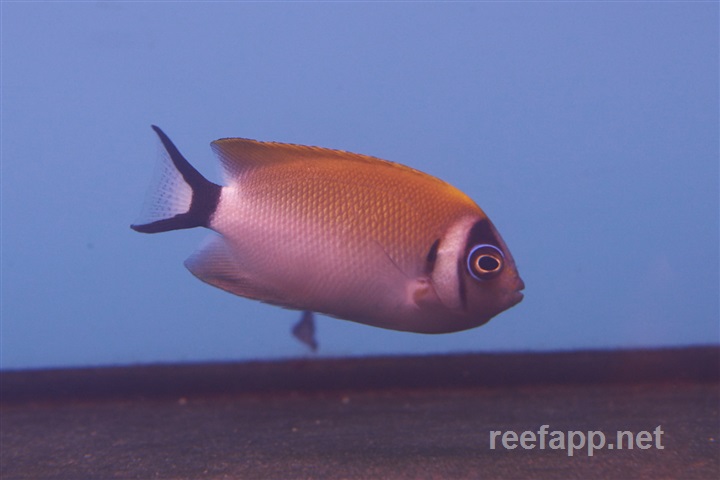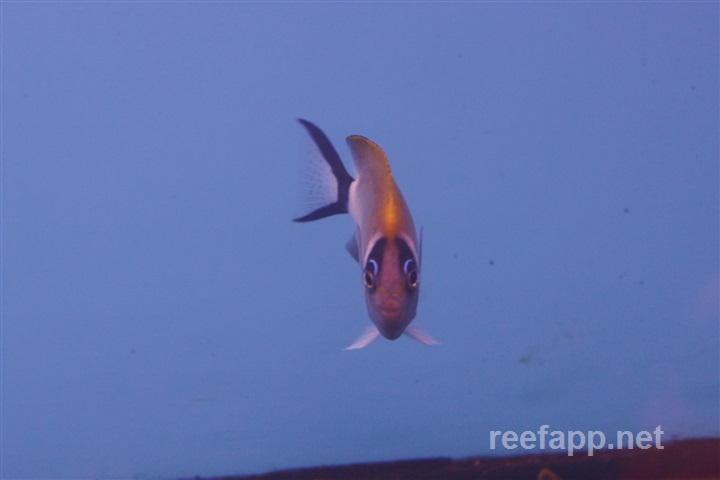Genicanthus semifasciatus


| Latin name | Genicanthus semifasciatus - (Kamohara, 1934) |
|---|---|
| Local name | Japanese swallow |
| Family | Pomacanthidae - Genicanthus |
| Origin | Japan, Indonesia, Central/West Pacific |
| Max length | 21 cm (8.3") |
| Minimum volume |
700 l (185 gal) |
|---|---|
| Hardiness |
Average |
| Suitable for aquarium |
Suitable with care |
| Reef safe |
Reef safe with caution |
| Aggressiveness | Might be aggressive towards similar species |
| Recommended |
Larger crustaceans (Shrimp, crabs...) Microalgea (Eg. spirulina) Small crustaceans (Krill, mysis, artemia...) |
|---|---|
| Mostly |
Zooplankton (Cyclops, pods...) |
| Maybee |
Macroalgea (Eg. seaweed / nori) Soft coral Sponges |
This species is known to jump out of open aquaria.
Some individuals of this species can find it hard to acclimatize, but others are problem free.
This species must be fed with an appropriately varied diet.
Out in wild this species is used to faint light, so to acclimitize it, it is advantageous to dim the light at first and gradually increase it to normal.
This fish requires feeding several times a day, especially when newly added.
When the fish can find its natural food in the aquarium it requires less frequent feeding.
These fish should be kept in a well run aquarium where they can "graze" algae from rocks and stones.
If there are insufficient algae on the rocks, it is important to feed more frequently and supplement with algae rich food e.g. Spirulina.
This species needs good hiding places, for example, between live rocks.
This species revels in swimming and requires an aquarium with ample space.
This species functions best as a pair (one male, one female), or one male with several females.
This species can change gender from female to male.
When a male is needed, a female changes sex and takes on the role.
It is possible to keep various different sizes of Angelfish in the same aquarium, but it means that one must choose species with care and that the conditions in the tank are optimum.
Here are some suggestions to increase the chances of success:
Choice of species
It is important not to choose species that are too similar, the greater the variance, the larger the chance of success. It is also advantageous to choose fish of different sizes. Two young Angelfish of the same same size and pattern for example are a bad idea. One should of course avoid the most aggressive species.
Order of introduction
It is a good idea to make a wishlist and choosing the order so, that the least aggressive are introduced first. When adding similar sized Ange fish it works best if they are introduced simultaneously.
Space
There should be enough space in the aquarium, but it is difficult to give specific advice. Of course there are exceptions to the table below as to just how big a tank should be in order to stand a good chance of success. Space itself is not enough, there should also be sufficient hiding places so the fish do not have to fight over these.
100 gal (400 liters): Several small Angelfish (<15cm) can live together.
240 gal (900 liters): Several medium Angelfish (< 20cm) can live together.
400 gal (1500 liters): Several large Angelfish (<25cm) can live together.
Food and water quality
It is always helpful to give the fish a varied diet, so they can withstand the occasional stress situation when for example new fish are introduced. Water quality must also be very high, so that the fish do not get stressed for that reason either.
Genicanthus (Lyretailed Angelfish) are distinguished from other Angelfish by their lyre like tail and in that they hunt zooplankton in the open.
Apart from zooplankton these fish also live of various micro algae, fish eggs and small invertebrates.
These fish are especially good candidates for coral aquaria, as unlike other Angelfish they rarely feed on corals. It can happen that they go for Xenia or similar, but it is normally not a problem.
There is, generally speaking quite a difference between the sexes and go together well as a pair. Females can change into males, even though there may already be a male present. If there already is a male, this "female" can then change back again, if the original one becomes aggressive towards this "new" male.
These fish normally live in deep water, so there is a possibility of injury when being caught. The females are normally better able to cope with this. A clear sign of an injury sustained, is when they cannot stay still in the water but must constantly swim downwards so as not to rise to the surface.
If the fish will not eat or are quite shy, it is good practice to have dimmed light for a while, to aid acclimitization.
Whilst males can be aggressive towards each other, females can happily co-exist even with individuals of other species.
They should all be added to the aquarium simultaneously.
Angelfish (Pomacanthidae) are known as some of the most colourful and impressive fish on the reef.
Many species are not reef safe, as they especially target the soft corals and LPS. But by choosing your corals carefully, or by getting specific species of Angelfish, they can be kept in coral aquariums.
There are Angelfish suitable for most aquarium sizes, from Dwarf Angelfish which are well suited to smaller aquaria, to the larger of the species which can be impressively displayed in a larger aquarium.
The demands of the individual species can vary widely. Some are food specialists and require therefore special food, while for others can be difficult to acclimatize, as they live in deep water in the wild. It is recommended that one has a reasonably good knowledge of the different types of food and of treatments of illnesses, if one wishes to keep the larger species.
| Aquarium trade | Yes |
|---|---|
| Distribution | Western Pacific: southern Japan to Taiwan and northern Philippines. |
| English common names |
Japanese swallow |
| Danish common names |
Japansk svalekejserfisk |
Henry C. Schultz. 2005. Swallowing One Victim at a Time: The Genus Genicanthus - Reefkeeping - (English)
Niels K. 2014. Private conversation - saltvandsforum.dk - (Danish)
Scott W. Michael. 2004. Angelfishes and Butterflyfishes (Reef Fishes Series Book 3) TFH Publications / Microcosm Ltd. - (English)
Bob Fenner. Marine Angelfishes, Family Pomacanthidae - Wet Web Media - (English)
Bob Fenner. The Best Angelfishes For Marine Aquarium Use - Wet Web Media - (English)
Bob Fenner. The Ultimate Angelfish Aquarium; An amazing and challenging collection of marine angelfishes - Wet Web Media - (English)
Collection of links to additional information - Wet Web Media - (English)
Reef Central. 2009. Keeping more than one emperor angelfish together - (English)

